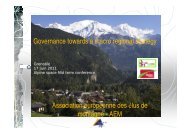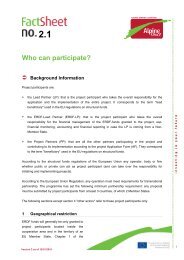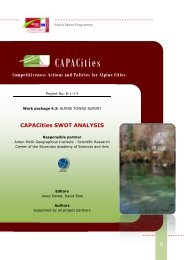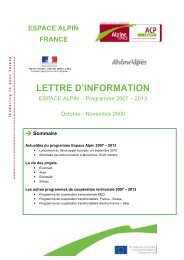aDaptation strategies to spatial planning anD regional Development
aDaptation strategies to spatial planning anD regional Development
aDaptation strategies to spatial planning anD regional Development
Create successful ePaper yourself
Turn your PDF publications into a flip-book with our unique Google optimized e-Paper software.
SWOT analysis in regions<br />
Challenging but worthwhile “homework”<br />
6<br />
How does SWOT analysis work?<br />
SWOT analysis is a strategic <strong>planning</strong> method which originates from classic<br />
economics. It identifies specific objectives of a project (or business)<br />
on the basis of the cross analysis of internal and external fac<strong>to</strong>rs that are<br />
linked <strong>to</strong> the planned subject.<br />
SWOT stands for Strengths – Weaknesses, Opportunities – Threats.<br />
The internal analysis primarily evaluates the<br />
Strengths and Weaknesses of a brand or<br />
product – or in this case, of a certain region.<br />
The second step is the identification of external<br />
fac<strong>to</strong>rs – potential Opportunities and<br />
Threats which may impact upon a specific<br />
region and its development i.e. the lack of<br />
qualified employees caused by a decreasing<br />
<strong>regional</strong> population. The combination of<br />
internal and external fac<strong>to</strong>rs creates a structured<br />
matrix that enables <strong>regional</strong> decision<br />
makers <strong>to</strong> elaborate <strong>strategies</strong> for future <strong>regional</strong><br />
development.<br />
Internal<br />
analysis<br />
Strengths<br />
Weakness<br />
es<br />
The web-based SWOT-<strong>to</strong>ol – a sustainable project result<br />
DEMOCHANGE project partners from Universities and institutions of applied<br />
sciences supported <strong>regional</strong> stakeholders in their consideration of<br />
components for in situ analysis. In order <strong>to</strong> simplify and structure the<br />
procedure for other regions, the project developed a web-based solution.<br />
The SWOT-<strong>to</strong>ol allows each region, district or institution <strong>to</strong> implement its<br />
own SWOT analysis. The results can be saved and extracted and used<br />
for further strategy development.<br />
• Thomas Bausch<br />
• Susanne Forster<br />
• Alexander Veser<br />
Opportunities<br />
Munich University<br />
of Applied Sciences,<br />
Department of Tourism<br />
External analysis<br />
Threats<br />
Strategies:<br />
objectives & measures<br />
Figure 1<br />
SWOT matrix<br />
Considering demographic trends and progression<br />
As overall analysis was not feasible, DEMOCHANGE concentrated on<br />
demographic aspects. This innovative approach features a <strong>to</strong>ol with preformulated<br />
trends and progression. Regarding external analysis, users<br />
may choose which demographic dimension or external fac<strong>to</strong>r relating <strong>to</strong><br />
demographic population development applies for any specific region. Examples<br />
of relevant questions may be as follows: How will the average<br />
size of households develop? Is the number of children and young people<br />
in our region decreasing, increasing or stable? How will this affect the<br />
region in the mid-term or long-term or is the trend consistent?<br />
Opportunity or Threat?<br />
Choices are made by <strong>regional</strong> stakeholders, decision makers and politicians.<br />
After entering the identified Strengths and Weaknesses and the<br />
external analysis by determination demographic dimensions, internal and<br />
external fac<strong>to</strong>rs are au<strong>to</strong>matically combined. At this step users are asked

















